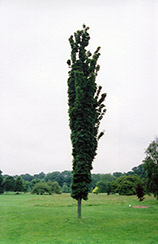Fri & Sat 8am - 8pm
Sun 8am - 7pm
Anytown, USA 12345
fax: 261.787.0463
e-mail: info@successgc.com


Plant Finder

Newton Sentry Sugar Maple
Acer saccharum 'Newton Sentry'
Height: 40 feet
Spread: 10 feet
Sunlight:
![]()
Hardiness Zone: 4a
Other Names: Hard Maple, Rock Maple
Description:
An almost shockingly narrow tree, with small branches held tightly upright along the trunk; use with caution and specific purpose, can really stand out in a crowd, great for a tall screen when used in a row; quite adaptable but intolerant of air pollution
Ornamental Features
Newton Sentry Sugar Maple is primarily valued in the landscape for its rigidly columnar form. It has dark green deciduous foliage. The lobed leaves turn yellow, orange and red in fall.
Landscape Attributes
Newton Sentry Sugar Maple is a deciduous tree with a narrowly upright and columnar growth habit. Its relatively coarse texture can be used to stand it apart from other landscape plants with finer foliage.
This is a relatively low maintenance tree, and should only be pruned in summer after the leaves have fully developed, as it may 'bleed' sap if pruned in late winter or early spring. It has no significant negative characteristics.
Newton Sentry Sugar Maple is recommended for the following landscape applications;
- Vertical Accent
- Hedges/Screening
Planting & Growing
Newton Sentry Sugar Maple will grow to be about 40 feet tall at maturity, with a spread of 10 feet. It has a low canopy with a typical clearance of 3 feet from the ground, and should not be planted underneath power lines. It grows at a slow rate, and under ideal conditions can be expected to live for 80 years or more.
This tree should only be grown in full sunlight. It prefers to grow in average to moist conditions, and shouldn't be allowed to dry out. It is not particular as to soil pH, but grows best in rich soils. It is somewhat tolerant of urban pollution. This is a selection of a native North American species.
